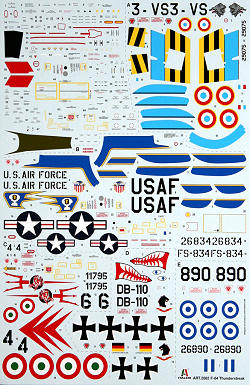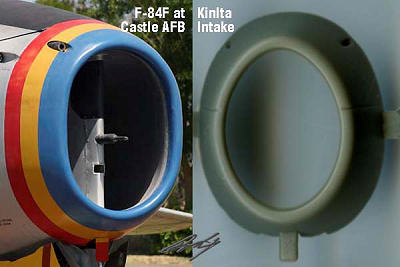
Italeri 1/48 F-84F Thunderstreak
| KIT #: | 2682 |
| PRICE: | $43.00 MSRP |
| DECALS: | options |
| REVIEWER: | Bruce Craig |
| NOTES: | Rebox of Kinetic kit. |

| HISTORY |
I bought this kit retail. The rumor mill, I suspect
initiated by Italeri, classified this kit as "new tools" so I was anxious to add
it to my collection. When the kit arrived and was opened (28th July 2009) I was
frustrated to learn it is a reissue of the Kinetic kit. In retrospect, it
appears I was the last one to "get the picture" that this was not "new tools"
but rather the same-ol' Kinetic kit in a new Italeri cover.
The ten years commencing in 1944 saw vast changes in aircraft designs and
performance capabilities. Though classified "P" for pursuit, during WW2
Republic's P-47 Thunderbolt proved to be the outstanding iteration of a ground
attack aircraft. At the coming of the jet age, Republic was commissioned to
develop their version of a pursuit jet (later revised to "F" for fighter under
the US's new USAF military division). Initial studies by Republic included
attempts to adapt the P-47 to jet power. Those studies failing, a clean sheet
was put on the drawing board and the P-84, soon to be named Thunderjet and later
redesignated F-84, resulted. With a clean tubular fuselage suitable for high
speeds but with straight wings (hence the moniker "Plankwing") designed to limit
maximum air speed, the Thunderjet was speed deficient. This was soon
demonstrated in the Korean war where the Thunderjet simply could not reasonably
engage the MiG-15 employed by North Koreans and, as has been proven, Chinese
pilots. The F-86A and subsequent Sabre versions, with their swept wings, became
the fighter de jure, and the Thunderjets, including F-84D, F-84E, and F-84G
models, were delegated to ground attack duty. They excelled in this role, as did
their P-47 predecessor, as they were a very stable ground attack platform as
well as being able to carry a wide variety of ordinances. Korean War statistics
show the Thunderjet flew more sorties during the Korean conflict than all other
deployed aircraft combined. Notably, the Thunderjet was also used as a test-bed
for numerous experimental programs undertaken during the learning-curve years of
the early jet age. These included in-flight refueling development, Zero-length
Launch and Mat Landing (ZELMAL), Fighter Conveyer proposals including Tip-Tow
and FICON, non-visual instrument-only flight reference with periscope
augmentation, and the Thunderjet was the first fighter aircraft fitted for
nuclear bomb delivery.
The success of the swept wing jets, MiG-15 and F-86 Sabre being examples, led
Republic to develop a swept wing version of the Thunderjet. Initially designated
YF-96A, the prototype was modified from an F-84E S/N 49-2430 diverted from the
production line. Swept wings and swept tail surfaces were fitted to the
generally unmodified Thunderjet fuselage, and the F-84E engine was retained.
Subsequent testing proved this prototype, initially called Thunderjet, but later
named Thunderstreak, was wanting for performance. A larger engine was needed,
but a suitable engine was too large to fit the Thunderjet fuselage. The original
plan was to retain some 80% of the Thunderjet tooling for the Thunderstreak thus
easing production transition and minimizing costs. Fitting the larger engine
meant revising the fuselage. This was accomplished by deepening the forward 60%
of the fuselage by seven inches and enlarging the aft fuselage to accommodate
the larger exhaust tube.
The fore and aft fuselage modifications were blended at approximately the aft
wing roots. The first few aircraft, by then designated F-84F, with the enlarge
fuselage retained the fiberglass-braced Thunderjet canopy. All production
Thunderstreaks were built with the clamshell canopy (and this canopy scheme was
retained for the RF-84F Thunderflash). In final production, less than 10% of the
Thunderjet tooling carried over to the Thunderstreak. Though now a substantially
different aircraft, politics lead military planners to keep the F-84 series
designation for the Thunderstreak and what was initially to be the F-96 was
redesignated F-84F. Notably, YF-96A 49-2430 survives and is displayed at the Air
Force museum at Dayton, Ohio as the YRF-84K FICON test bed.
As with the Thunderbolt and the Thunderjet, the Thunderstreak proved to be
better in a ground attack role rather than as a fighter. It too was fitted to
carry nuclear weapons, and also served in many experimental programs, plus
continuing in Fighter Conveyer tests as Tom-Tom and active duty as RF-84K FICON.
For practical production and entry in to service, the Thunderstreak suffered
from three major setbacks. First, the main wing spar was designed as a forging.
Unfortunately, the only suitable forge press was dedicated to B-47 production.
The F-84F production schedule was delayed while Republic redesigned the
carry-through spar. Second, the F-84F initially suffered from stablity problems.
Attempts to resolve these problems included aileron and rudder coupling (as used
on the Ercoupe) then, later, by changing the traditional
fixed-horizontal-stabilizer-with-elevator design to a flying-tail design. Also,
the vertical tail was extended vertically to provide additional rudder area
(thus the "short-tail" and the "long-tail" versions --- all RF-84F are
"long-tail"). Third, a shortage of reliable engines resulted in numerous
otherwise completed airframes languishing on the apron at the Republic factory.
The combination of these delays plus the substantial redesign
and tooling lead to substantial cost overruns and a delay of some two years past
the original intended date for entry into service.
Though the Thunderstreak was, in relative terms, late to the party, it served in
front-line duty for a number of countries, final retirement came only in the
late 1980's.
| THE KIT |
 This
Italeri release is the Kinetic kit with (a) new box art and (b) outstanding
decal sheet. The box art depicts F-84F-51-GK 52-9075 as French AF 3-VS of EC 1/3
Ardennes, Suez Crisis, Akrotiri AFB, Cyprus, October 1956. The decal sheet
offers markings for five aircraft. They are:
This
Italeri release is the Kinetic kit with (a) new box art and (b) outstanding
decal sheet. The box art depicts F-84F-51-GK 52-9075 as French AF 3-VS of EC 1/3
Ardennes, Suez Crisis, Akrotiri AFB, Cyprus, October 1956. The decal sheet
offers markings for five aircraft. They are:
F-84F-51-GK 52-9075 France 3-VS
EC 1/3 Aredennes, Suez Crisis, Akrotiri AFB Cyprus, October 1956
F-84F-50-RE 52-6834 USAF FS-834
81st FBW 91st FBS, RAF Bentwaters AFB, UK, 1958
F-84F-30-RE 51-1796 AMI 6-4
154 gruppo 6a Areobrigata, Ghedi AFB, Brescia, Italy (no date cited)
F-84F-81-RE 53-7206 Luftwaffe DB-110
1/JaboG 32 "Hammerhead Shark" 5th Fursenfeldbruck AFB, Germany, 1961
F-84F-50-RE 52-6890 Hellenic AF 690
347 Mira, 110 Combat Wing, Larissa AFB, Greece, 1972
The decal sheet is the "good news" for this kit. Strap in tightly, it is a steep
dive-bomb hereafter.
In the box are five sprues, the decal sheet, and a 12-page instruction booklet
(A4 size). Four sprues are medium gray, one is clear. At this point, it is
appropriate to make clear that this kit, as originally from Kinetic, and
unchanged in this Italeri iteration, is generally a direct copy of the Monogram
cum Revell (hereinafter RevMon) kit of the early 1980's with the added "bonus"
of a generally direct copy of the Tamiya Thunderjet weapons bay and access
panel. That is to say, both the good and the bad of the RevMon kit are present
in this kit. Please note, I'm not degrading the RevMon kit; it is, at this
writing, the best 48th scale F-84F available. Unfortunately, the Kinetic cum
Italeri kit (hereinafter Kinetic) is a degraded version of the RevMon. The
RevMon is incorrect in profile at the ventral section in the aft wing root area.
Also, it is neither "short-tail" nor "long-tail" being somewhere between.
Otherwise, it is generally a good representation of the real deal. Yes, the
RevMon has raised panel lines, but they are finely done and in little need for
rescribing except by those with Advanced Modelers' Syndrome. The Kinetic has
trench-sized engraved panel lines (only a slight exageration on my part --- they
are certainly way out of scale). The Kinetic has "bonus" added panel lines that
are correct for the RF-84F but not the F-84F. The RevMon has a polished surface
out of the mold; in contrast, the Kinetic has a textured surface which will need
fine sanding to be suitable for a natural metal finish. The RevMon has quite
good details in cockpit and gear parts; the Kinetic "duplicates" these parts but
with degraded detail crispness. The "bonus" addition of the weapons bay by
copying the Tamiya Thunderjet details means the option is there for an open
weapons bay; but again, the details are degraded by the copying process. BUT
WAIT, THERE'S MORE!
THE REAL "KIT-KILLER" PRESENT IN THE Kinetic KIT IS THE INTAKE.

One significant detail Kinetic did not copy from the RevMon is the intake. The
original Thunderjet had a round intake. The intake on the Thunderstreak was
accomplished by inserting two seven-inch-long straight parts into the halved
round Thunderjet intake. The result is two 180-degee arcs separated by two
straight vertical segments. The engineers (note that I'm giving the benefit of
the doubt with the use of the word "engineers") at Kinetic elected to make the
intake "lemon" shaped which is grossly incorrect. No other F-84 kit ever
released, notwithstanding their other "warts," has an incorrect intake shape.
Even the Hawk "Thunderjet" 72nd scale YF-96A from the late 1950's, which has the
incorrect F-84F intake in place of the round YF-96A intake, is still the correct
shape for the F-84F.
| CONCLUSIONS |
To my way of thinking, I should praise work well done. Likewise, I feel am not doing modeler's a favor if I gild the pig. The decals are great, the kit is otherwise deficient. I am in favor of supporting kit manufacturers when their products are worth supporting. My collection of RevMonProMod and Tamiya F-84E/G and RevMon F-84F kits attest to that (I've lost count, but I have around 30 Thunderjet kits and 10 Thunderstreak kits --- that estimate does not include my stash of 48th scale releases by others from Hawk to Collect-Aire to Battle Axe, etc., plus several Heller/Fonderie F-84F and RF-84F kits --- and yes I have this kit and a Kinetic kit, sadly now only for review purposes).
Sometimes manufacturer's products are not worth supporting.
I have the hope that lack of sales of this kit will send the message to those
behind it that modelers will not support their shortcut efforts. My message to
kit producers: Tooling costs the same whether done from poorly
done or well done research. Do your homework and quit taking shortcuts. Every
bit of information needed to make a correct model was available to you but you
didn't do the research. Instead, you depended on ripping-off two other existing
kits by other manufacturers. Shame on you. This could have been a great kit, but
"could have been" doesn't cut it, and this is a substandard kit.
In short, no matter how this kit is inspected, it falls short of the much less
expensive RevMon offering. I cannot recommend this kit whether as Kinetic or
Italeri. My opinion is, stick with the RevMon which is better in every way than
the Kinetic kit and is less expensive as well. Whether straight from the box or
with aftermarket details (such as the AMS Resin detail sets and available PE
frets and decals), the RevMon can be built into an outstanding representation of
the Thunderstreak. Whether for Kinetic or Italeri releases of this kit, the
value for price doesn't connect. Caveat emptor.
Bruce Craig
August 2009
If you would like your product reviewed fairly and quickly, please
contact
me or see other details in the
Note to
Contributors.